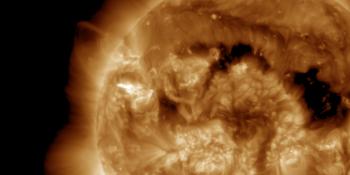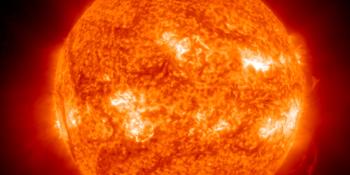Przeglądasz Archiwum z czwartek, 15 maja 2003
Raport aktywności słonecznej
Każdy wspomniany rozbłysk słoneczny w tym raporcie ma współczynnik skalowania dodany przez Space Weather Prediction Center (SWPC). Przez skale współczynników SWPC, raporty o rozbłyskach słonecznych są o 42% mniejsze niż naukowo jakościowa data. Skale współczynników zostały usunięte z naszych archiwów o rozbłyskach słonecznych by odzwierciedlić prawdziwe jednostki fizyczne.
Raport aktywności słoneczno- geomagnetycznej 2003 May 15 2200 UTCPrzygotowane przez NOAA © SWPC i przetworzone przez SpaceWeatherLive.com
Połączenie raportów USAF/NOAA o słonecznej i geofizycznej aktywności
Numer SDF 135 wydany w 2200Z na 15 May 2003IA. Analiza aktywności regionów słonecznych i aktywność od 14-2100Z do 15-2100Z Solar activity has been low. Two new regions were
numbered today: Region 361 (N09E39) and Region 362 (S10E77).
IB. Prognoza aktywności słonecznej
Solar activity is expected to be very
low, with possible increase in activity over the next few days due
to active regions emerging from the east limb. New region 362 may
produce isolated flare activity.
IIA. Podsumowanie aktywności geofizycznej 14-2100Z do 15-2100Z
The geomagnetic field has been at unsettled to minor storm levels due
to a high speed solar wind stream from a favorably positioned
coronal hole. The greater than 2 MeV electron flux at
geosynchronous orbit reached high levels today.
IIB. Prognoza aktywności geofizycznej
The geomagnetic field is
expected to be at unsettled to active levels for the next three
days. Solar wind speeds should continue to reduce over the next few
days, and may cause isolated minor storm levels on day one.
III. Prawdopodobieństwa zdarzenia 16 May do 18 May
| Klasa M | 10% | 15% | 20% |
| Klasa X | 01% | 01% | 01% |
| Proton | 01% | 01% | 01% |
| PCAF | green | ||
IV. Przepływ 10,7 cm z Penticton
Zaobserwowano 15 May 099 Przewidywane 16 May-18 May 105/110/120 Średnia z 90 dni 15 May 123
V. Indeks geomagnetyczny A
Zaobserwowano Afr/Ap 14 May 017/027 Szacowane Afr/Ap 15 May 015/022 Przewidywane Afr/Ap 16 May-18 May 010/015-010/015-015/015
VI. Prawdopodobieństwa aktywności geomagnetycznej 16 May do 18 May
| A. Średnie szerokości geograficzne | |||
|---|---|---|---|
| Aktywne | 25% | 25% | 25% |
| Słaba burza | 15% | 10% | 10% |
| Bardzo znacząca burza | 05% | 01% | 01% |
| B. Wysokie szerokości geograficzne | |||
|---|---|---|---|
| Aktywne | 35% | 35% | 35% |
| Słaba burza | 15% | 15% | 15% |
| Bardzo znacząca burza | 05% | 05% | 05% |
Wszystkie czasy w UTC
<< Idź do codziennego przeglądu
Najnowsze wiadomości
Najnowsze wiadomości z forum
AR 3959 14IP cameras for sky surveillance 41Comet C/2024 G3 (ATLAS) in LASCO C3 10Unspecified geomagnetic activity 1836Filaments and prominences 612
Więcej tematówWesprzyj SpaceWeatherLive.com!
Wielu ludzi odwiedza SpaceWeatherLive aby śledzić aktywność słoneczną lub sprawdzić czy jest szansa na zaobserwowanie zorzy polarnej. Niestety, większy ruch na stronie oznacza większe koszty utrzymania serwera. Dlatego, jeśli jesteś zadowolony ze strony SpaceWeatherLive, zachęcamy do wspierania nas finansowo. Dzięki temu będziemy mogli utrzymać naszą stronę.

Fakty na temat pogody kosmicznej
| Ostatnie rozbłyski klasy X | 2025/01/04 | X1.85 |
| Ostatnie rozbłyski klasy M | 2025/01/09 | M1.1 |
| Ostatnia burza geomagnetyczna | 2025/01/04 | Kp5 (G1) |
| Dni bez plam słonecznych | |
|---|---|
| Ostatni dzień bez skazy | 2022/06/08 |
| Średnia miesięczna liczba plam słonecznych | |
|---|---|
| grudnia 2024 | 154.5 +2 |
| stycznia 2025 | 140.8 -13.8 |
| Ostatnie 30 dni | 151.7 +34.3 |


